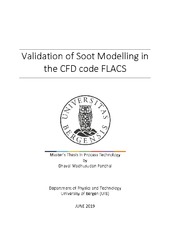| dc.description.abstract | In a fire scenario, the role of soot is important from different standpoints. It has a significant contribution to heat transfer by radiation and it proves to be a hindrance in evacuation activities as it reduces visibility. As a pollutant from combustion, it is an environmental hazard and it contributes to climate change by causing a very localised warming effect in the atmosphere. A predictive and practical soot model will be extremely helpful to all the design engineers who are working towards solving these problems. The computational fluid dynamics (CFD) codes, compiled on advanced computing machines of this generation are more than capable of predicting soot concentration and its contribution to radiation. However, these CFD tools need to be validated against experiments. This involves recreating the experimental setup in the CFD environment and comparison of the results from the simulation with the experimental results. The focus of this thesis is to validate the soot models used in FLACS Fire, a CFD code developed by Gexcon AS. Four fire scenarios from experiments, ranging from small scale such as ethylene jet flame to full scale such as underventilated compartment fire, are selected here. The Formation-Oxidation model (FOX) and Conversion Factor Model (CFM) are the two options used in FLACS to predict soot fractions. The validation is done for result parameters, such as time-averaged temperatures and mass or volume fractions of soot. Soot is a good radiator and it transfers a substantial amount of energy to the surroundings by thermal radiation. This transfer of energy will change the temperature field of the flame. This impact of soot fraction on radiative power is also studied and discussed. Sensitivity study with respect to certain modelling parameters is also included. The results of average temperature and average soot mass or volume fraction predicted by CFM are in good agreement with the measurements from experiments. However, the predictions of soot fractions using the FOX model are very low compared to experimental values, and a need for code improvement and further validation is identified. The results of temperature are strongly influenced by soot fractions predicted accordingly by the soot models. Apart from experiments, results from another CFD code Fire Dynamic Simulator (FDS), are used for comparison in a compartment fire case. The importance of soot formation is tested by using no soot model for the compartment fire scenario and demonstrated that the temperatures are over-predicted, and using an appropriate soot model for the given fire scenario is essential. | en_US |
